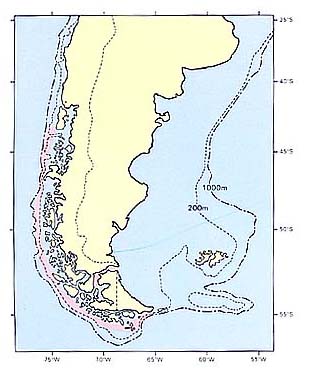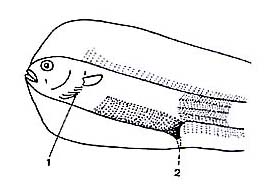ゲンゲ科
- HOME
- デジタル図鑑
- パタゴニア海域の重要水族
- 硬骨魚綱 スズキ目
- ゲンゲ科
ゲンゲ科(Zoarcidae)

91 ミナミカンテンゲンゲ(Minami-kantengenge)
Melanostigma gelatinosum Günther, 1881
特 徴:
背鰭108軟条,臀鰭99軟条,胸鰭7軟条,脊椎骨数20+63=83。頭長は全長の12.8%,眼径は2.5%,体高は11.4%,吻長は5.0%,上顎長は5.4%,胸鰭長は4.9%,背鰭前長は15.9%,臀鰭前長は32.2%,胸鰭前長は15.5%。体は延長して,著しく側扁する。体長は体高の約9倍。皮膚は柔軟で,鱗はない。頭は小さく,体長は頭長の約8倍。吻は非常に短く,吻長は眼径の約2倍。両顎は同長で,斜位。上顎後端は眼の前縁下に達する。両顎歯は鋭く,そり返った円錐歯で1列に並ぶ,下顎では縫合部附近で歯列は不規則になる。小円錐歯が鋤骨と口蓋骨にある。眼は小さく,頭長は眼径の約5.5倍。両眼間隔域は狭く,その幅はほぼ眼径に等しい。鰓孔は小さく,その幅は胸鰭基底長とほぼ等しい。背鰭起部は鰓蓋後縁のわずかに後方に位置する。背鰭と臀鰭は皮膚におおわれ体部と明確に区別し難く,両者の基底はともに長いが,背鰭基底の方が臀鰭基底よりもわずかに長い。腹鰭はない。胸鰭は短く,胸鰭長はほぼ吻長に等しく,頭長の約1/3。鼻孔は1対で,管状を呈し,吻端と眼の前縁を結ぶ距離のほぼ中間に位置する。口腔,鰓腔,両顎,鼻管,鰓孔の周囲および尾部後縁は黒味を帯びる。体色は半透明を呈し,微小な暗色斑点が体中に散在する。黒味を帯びた腹膜と脊椎骨は皮膚を通して見える。
分 布:
チリ パタゴニア,マゼラン海峡;南極海,亜南極水域からも知られている(Norman, 1938)。
備 考:
パタゴニアからはMelanostigma属魚類として,M. microphthalmus Norman, 1937とM. bathium Busshing, 1965がそれぞれアルゼンチン側とチリ側から知られている。
(中村 泉)
Material examined:
1 from Chile (220.0 mm TL), FAKU CP 66.
Description:
D 108; A 99; P1 7; Ⅴ 20+63=83. HL 12.8% of TL; ED 2.5; BD 11.4; SN 5.0; UJ 5.4; P1L 4.9; PreD 15.9; PreA 32.2; PreP1 15.5.
Body elongate, extremely compressed, body depth about 9 times in SL. Skin loose, naked. Head small, about 8 times in SL. Snout very short, its length about 2 times of eye diameter. Mouth oblique, terminal, posterior margin of upper jaw extending to anterior margin of eye. Jaw teeth sharp conical, recurved; uniserial on upper jaw, several irregular rows near symphysis and uniserial laterally on lower jaw. Small conical teeth on vomer and palatines. Eye small, about 3.5 times in head. Interorbital narrow, its width about equal to eye diameter. Gill-opening small, about equal to pectoral fin base length. Dorsal fin origin just posterior to head. Dorsal and anal fins not clearly delimited from body, both with long base, dorsal fin base slightly longer. No pelvic fins. Pectoral fin short, nearly as long as upper jaw, about one-third of head length. A nostril short tube-like, situated between snout tip and anterior margin of eye. Buccal and branchial cavities, both jaws, tube of nostril, margin of gill-opening and tip of tail black. Body translucent with dusky fine spots scattered, so black peritonium and vertebrae visible through skin.
Distribution:
Chilean Patagonia and Straits of Magellan; also known from the Antarctic and Subantarctic zones (Norman, 1938).
Remarks:
In this region, there are two more species of Melanostigma, M. microphthalmus Norman, 1937 from Argentine Patagonia and M. bathium Bussing, 1965 from Chilean Patagonia. The latter differs from all other Melanostigma in being nearly colorless and having a complete supratemporal canal and no temporal pore (Bussing, 1965).
(Izumi NAKAMURA)

Distribution of Melanostigma gelatinosum in Patagonia.

Anterior part of body. Branchiostegals (1) and anus (2).